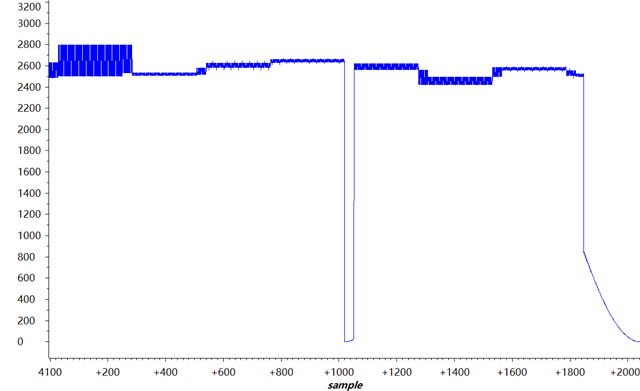/*
* main.c
*
* Created on: 2023年9月14日
* Author: CHENJIE
*/
#include "RFFT.h"
#include "epwm.h"
#include "DSP2833x_Device.h"
#include "DSP2833x_Examples.h"
#include "adc.h"
#include "epwm.h"
#include "stdio.h"
#include "uart.h"
#include "dma.h"
#include "leds.h"
__interrupt void adc_isr(void);
__interrupt void ocal_DINTCH1_ISR(void);
float freq;
Uint16 array_index;
Uint16 check_flag;
Uint16 LoopCount;
Uint16 ConversionCount;
//#pragma DATA_SECTION(DMABuf1,"DMARAML4");
//#define DMA_BUF_SIZE 60
//volatile Uint16 DMABuf1[DMA_BUF_SIZE];
#pragma DATA_SECTION(Voltage1, "DMARAML4");
Uint16 Voltage1[2048];
volatile Uint16 *DMADest;
volatile Uint16 *DMASource;
void main()
{
check_flag=0;
//
// Step 1. Initialize System Control:
// PLL, WatchDog, enable Peripheral Clocks
// This example function is found in the DSP2833x_SysCtrl.c file.
//
InitSysCtrl();
// MemCopy(&RamfuncsLoadStart,&RamfuncsLoadEnd,&RamfuncsRunStart);
// InitFlash();
EALLOW;
#if (CPU_FRQ_150MHZ) // Default - 150 MHz SYSCLKOUT
//
// HSPCLK = SYSCLKOUT/2*ADC_MODCLK2 = 150/(2*3) = 25.0 MHz
//
#define ADC_MODCLK 0x3
#endif
#if (CPU_FRQ_100MHZ)
//
// HSPCLK = SYSCLKOUT/2*ADC_MODCLK2 = 100/(2*2) = 25.0 MHz
//
#define ADC_MODCLK 0x2
#endif
EDIS;
//
// Define ADCCLK clock frequency ( less than or equal to 25 MHz )
// Assuming InitSysCtrl() has set SYSCLKOUT to 150 MHz
//
EALLOW;
SysCtrlRegs.HISPCP.all = ADC_MODCLK;
EDIS;
//
// Step 2. Initialize GPIO:
// This example function is found in the DSP2833x_Gpio.c file and
// illustrates how to set the GPIO to it's default state.
//
// InitGpio(); // Skipped for this example
//
// Step 3. Clear all interrupts and initialize PIE vector table:
// Disable CPU interrupts
//
DINT;
//
// Initialize the PIE control registers to their default state.
// The default state is all PIE interrupts disabled and flags
// are cleared.
// This function is found in the DSP2833x_PieCtrl.c file.
//
InitPieCtrl();
//
// Disable CPU interrupts and clear all CPU interrupt flags:
//
IER = 0x0000;
IFR = 0x0000;
//
// Initialize the PIE vector table with pointers to the shell Interrupt
// Service Routines (ISR).
// This will populate the entire table, even if the interrupt
// is not used in this example. This is useful for debug purposes.
// The shell ISR routines are found in DSP2833x_DefaultIsr.c.
// This function is found in DSP2833x_PieVect.c.
//
InitPieVectTable();
//
// Interrupts that are used in this example are re-mapped to
// ISR functions found within this file.
//
// EALLOW; // This is needed to write to EALLOW protected register
// PieVectTable.ADCINT = &adc_isr;
// EDIS; // This is needed to disable write to EALLOW protected registers
EALLOW; // Allow access to EALLOW protected registers
PieVectTable.DINTCH1= &local_DINTCH1_ISR;
EDIS; // Disable access to EALLOW protected registers
PieCtrlRegs.PIEIER1.bit.INTx1 = 1;
IER |= M_INT7; // Enable CPU Interrupt 1
//
// Step 4. Initialize all the Device Peripherals:
// This function is found in DSP2833x_InitPeripherals.c
//
// InitPeripherals(); // Not required for this example
InitAdc(); // For this example, init the ADC
//
// Step 5. User specific code, enable interrupts:
//
//
// Enable ADCINT in PIE
//
// PieCtrlRegs.PIEIER1.bit.INTx6 = 1;
// IER |= M_INT1; // Enable CPU Interrupt 1
EINT; // Enable Global interrupt INTM
//ERTM; // Enable Global realtime interrupt DBGM
LoopCount = 0;
ConversionCount = 0;
//
// Configure ADC
//
AdcRegs.ADCTRL1.bit.ACQ_PS = 0Xf;
AdcRegs.ADCTRL3.bit.ADCCLKPS = 0x0; //不对高速时钟分频
AdcRegs.ADCTRL1.bit.CONT_RUN = 0; // Setup continuous run
AdcRegs.ADCMAXCONV.all = 0x0000; // Setup 2 conv's on SEQ1
AdcRegs.ADCCHSELSEQ1.bit.CONV00 = 0x0; // Setup ADCINA3 as 1st SEQ1 conv.
//
// Enable SOCA from ePWM to start SEQ1
//
AdcRegs.ADCTRL2.bit.EPWM_SOCA_SEQ1 = 1;
AdcRegs.ADCTRL2.bit.INT_ENA_SEQ1 = 1; // Enable SEQ1 interrupt (every EOS)
//
// Assumes ePWM1 clock is already enabled in InitSysCtrl();
//
EPwm1Regs.ETSEL.bit.SOCAEN = 1; // Enable SOC on A group
EPwm1Regs.ETSEL.bit.SOCASEL = 4; // Select SOC from from CPMA on upcount
EPwm1Regs.ETPS.bit.SOCAPRD = 1; // Generate pulse on 1st event
EPwm1Regs.CMPA.half.CMPA = 20; // Set compare A value
EPwm1Regs.TBPRD = 75-1; // Set period for ePWM1
EPwm1Regs.TBCTL.bit.CTRMODE = 0; // count up and start
EALLOW;
SysCtrlRegs.PCLKCR3.bit.DMAENCLK = 1; // DMA Clock
EDIS;
// Initialize DMA
DMAInitialize();
// Configure DMA Channel
DMADest=&Voltage1[0];
DMASource=&AdcMirror.ADCRESULT0;
DMACH1AddrConfig(DMADest,DMASource);
DMACH1BurstConfig(31,0,2);
//
// so need to increment by 2 to grab the correct location
//
DMACH1TransferConfig(31,0,2);
DMACH1WrapConfig(0xFFFF,0,0xFFFF,0);
//Use timer0 to start the x-fer.
//Since this is a static copy use one shot mode, so only one trigger is needed
//Also using 32-bit mode to decrease x-fer time
DMACH1ModeConfig(DMA_SEQ1INT,PERINT_ENABLE,ONESHOT_DISABLE,CONT_ENABLE,SYNC_DISABLE,
SYNC_DST,OVRFLOW_DISABLE,THIRTYTWO_BIT,CHINT_END,CHINT_ENABLE);
StartDMACH1();
//
// Wait for ADC interrupt
//
for(;;)
{
if(check_flag==1)
{
RFFT_ADC_Init(Voltage1);
RFFT_ADC_Caculate();
EPwm1Regs.ETSEL.bit.SOCAEN = 1;
StartDMACH1();
check_flag=0;
}
}
}
//
// adc_isr -
//
__interrupt void
local_DINTCH1_ISR(void)
{
//
// EALLOW;
// SysCtrlRegs.PCLKCR3.bit.DMAENCLK = 0; // DMA Clock
// EDIS;
// Voltage1[ConversionCount] = AdcRegs.ADCRESULT0 >>4;
//
// //
// // If 40 conversions have been logged, start over
// //
// if(ConversionCount > 2048)
// {
//
// ConversionCount = 0;
// EPwm1Regs.ETSEL.bit.SOCAEN = 0; // Enable SOC on A group
// check_flag=1;
//
// }
// else
// {
// ConversionCount++;
// }
//
// //
// // Reinitialize for next ADC sequence
// //
EPwm1Regs.ETSEL.bit.SOCAEN = 0; // Enable SOC on A group
AdcRegs.ADCTRL2.bit.RST_SEQ1 = 1; // Reset SEQ1
AdcRegs.ADCST.bit.INT_SEQ1_CLR = 1; // Clear INT SEQ1 bit
PieCtrlRegs.PIEACK.all = PIEACK_GROUP1; // Acknowledge interrupt to PIE
//
// return;
check_flag=1;
PieCtrlRegs.PIEACK.bit.ACK7 = 1;
}
使用epwm触发adc采样,dma传输时数据异常

